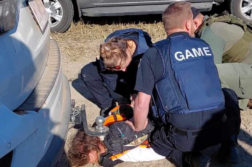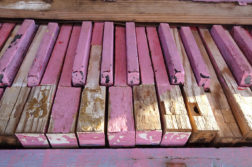Is this the age of the modern family? Reproductive technologies and non-heterosexual parenting arrangements have produced all manner of new families. And new research on parenting shows how functional these families are. Laws in Australia are adapting to these new arrangements — but traditional ideas about biology and gender continue to influence the way legislators and judges think about parenting.
Traditional imaginings of family often evoke the image of a mother and a father, in a married relationship, with children, maybe even a pet. The Australian Christian Lobby’s advocacy at the parliamentary inquiry into same-sex couple adoption reminds us that such images still have considerable traction. For them, parenting must be understood in the context of an "inherent gender complementarity" — mothers who nurture, fathers who discipline.
The policy debates on recognising "non-traditional" families in Australian parliaments over the past few years have turned on belief that you need a man and a woman to nurture a child. Emerging social scientific, psychological and medical research on same-sex parenting, however, has unsettled this commitment to heterosexual parenting. In 2010, the American Academy of Pediatrics released the largest ever-longitudinal study mapping the lives of 78 children living in lesbian headed households. Rather than evince the oft-stated deficiencies of such parenting structures, adolescents demonstrated better academic performances, less rule breaking or aggressive behaviour, and better social relationships with peers. Notably, researchers Nanette Gartrell and Henry Bos emphasised that it is the processes of parenting, rather than the family structure that matters.
And alternatives to the nuclear family certainly exist in Australia. The Australian Bureau of Statistics reports that 20 per cent of female same-sex couples and 5 per cent of male same-sex couples have children. (These statistics are limited in two respects. Firstly, the information was gathered prior to the raft of reforms on access to assisted reproductive technologies. Secondly, the official published data is almost a decade old.)
Recent legislative reforms are trying to keep up with the diversity of couples and families in Australia. In 2008, amendments to the federal Family Law Act provided for the recognition of the female de facto partner of the birth mother as a second parent. In 2010, NSW made moves to further the interests of these children, and passed legislation to permit same-sex couple adoption and surrogacy.
Even so, non-biological same-sex parents still struggle for appropriate recognition. The 2009 case of Keaton and Aldridge concerned a child conceived to two women through artificial insemination. The court found that the non-biological mother in the case, Keaton, struggled to establish a "mutual commitment to a shared life". In deciding to be a parent, Keaton stated to Aldridge, the biological mother:
"I don’t want to push you into a [sic]being a mother, and I’m not suggesting that I want to have anymore children. Having children has to be your decision for yourself and for your life…I will be as much or as little in your child’s life as you want."
Interpreting this submission, the judge discerned that this negotiated understanding of parenting undermined the shared desire to be parents. Effectively, the ambiguity of the situation was interpreted by the court as an apparent lack of a shared commitment. As legal academic Jenni Milbank notes, decisions like this offer no space for negotiated forms of parenting in the context of same-sex couples, where biology and legal recognition are distinctly different to heterosexual circumstances.
Negotiating the ever-obscure relationship between biology and nurturing has been critical to the regulation of surrogacy in Australian jurisdictions, a relatively recent phenomenon. Non-discriminatory surrogacy legislation exists in NSW, Victoria, the Australian Capital Territory, Queensland and Western Australia. For example, in NSW the Surrogacy Act came into effect late in 2010. It aims to regulate the processes by which a consenting woman/birth mother bears a child for another person or couple intending to be the parents.
Parentage presumptions at the federal level and in NSW currently recognise the birth mother (and her de facto partner if any) as the parents of a child, whether or not a genetic connection exists between the child and mother. This is relevant in cases where another embryo has been implanted. Under the Family Law Act, parentage does not extend to the sperm donor, unless a child is conceived through sexual intercourse.
Correspondingly, transfers of parentage in surrogacy arrangements do not require a genetic link between the parents-to-be and the conceived child. Nor does a presumption of parentage require a genetic connection to the child, as is sometimes the case for a birth mother inseminated with another’s embryo.
The traditional emphasis on biology is further complicated by NSW surrogacy legislation that includes social infertility alongside medical infertility as a valid reason for accessing surrogacy. Such provisions recognise the predicament of male same-sex couples.
Even so, there remain problematic gendered and biological divisions in the Surrogacy Act. While eligibility for male same-sex couples and single men is covered in broad terms, eligibility for women accessing surrogacy is confined to those unable to reproduce "naturally" or those who suffer health risks if required to undergo a pregnancy. Limiting eligibility for women in parochial medical terms may adversely affect women or sex and/or gender diverse people who, for social and psychological reasons, do not wish to undergo the process of reproductive labour. Biology becomes important for women — but not for men.
The new laws regulate altruistic surrogacy but commercial surrogacy remains expressly prohibited. This last is a fraught issue. On the one hand, there are real concerns over the exploitation of female reproductive labour. The Surrogacy Act clearly specifies the "reasonable expenses" that can be paid to the birth mother so individuals and couples can avoid entering into a commercial agreement.
Regardless of whether one supports or condemns commercial surrogacy, the extension of criminal sanctions outside the jurisdiction of NSW is deeply troubling. Amendments to the legislation were introduced during the parliamentary debate of the legislation to deter what has been commonly referred to as the commercialisation of children. It’s also worth noting in passing that the policy rationale here is a paternalistic concern for exploitation of women from poor countries where commercial surrogacy is permitted.
Rodney Chiang-Cruise, moderator of Gay Dads Australia, offers some insight into the lives of gay men negotiating this complex terrain. In an interview with JoyFM, he said:
"There is always a risk that there is exploitation in any commercial transaction — whether it be for surrogacy or whether we’re getting a 15-year-old kid in Vietnam making our shoes — I mean, there’s always that possibility for commercial exploitation."
As Chiang-Cruise points out, extraterritorial criminal sanctions do not address the structural issues behind commercial surrogacy arrangements. They may not act as a deterrent and indeed may create a situation where a parent who seeks a parenting or adoption order may risk criminal prosecution and up to two years in prison.
We need to carefully consider what policy ends are served by providing punitive treatment to parents who legally obtain surrogacy agreements in other jurisdictions?
Protecting the best interests of children requires provisions that recognise transfers of parental status legally conducted overseas. This will ensure that children do not become potentially stateless because they are not recognised either in NSW or in the country of their birth.
With the expansion of reproductive choices and family structures, the law and decision-makers must be flexible enough to ensure the recognition of all children, regardless of how they were conceived. In order to do so, lawmakers need to shift beyond a nuclear model of procreative parenting and consider alternative parenting arrangements. It might be a political cliché but what is at stake here is nothing less than the best interests of children.
Like this article? Register as a New Matilda user here. It’s free! We’ll send you a bi-weekly email keeping you up to date with new stories on the site.
Want more independent media? New Matilda stays online thanks to reader donations. To become a financial supporter, click here.
Donate To New Matilda
New Matilda is a small, independent media outlet. We survive through reader contributions, and never losing a lawsuit. If you got something from this article, giving something back helps us to continue speaking truth to power. Every little bit counts.



